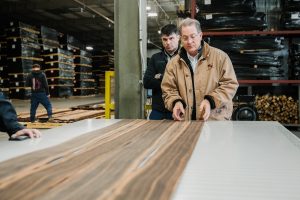
Particle Board vs. MDF
Back in the 1970s, particle board was the go-to choice for furniture and cabinetry. It was affordable and easy to produce, which made it popular during a time when efficiency often outweighed longevity. But the industry has evolved, and so have expectations for performance and quality.
Over the years, the weaknesses of particle board have become hard to ignore. The material absorbs moisture easily, swells and warps, and can lose its structural integrity in high-humidity environments. These issues make it less than ideal for modern projects that require durability and precision.
The Rise of MDF
Medium-density fiberboard, or MDF, has changed the game for wood products. Although it has been around for more than 25 years, many still overlook its advantages. MDF offers a smoother, denser surface that holds up better against environmental changes. It’s stronger, more consistent and easier to machine. For only a small increase in cost—roughly 10% to 15%—you gain a product that outperforms both particle board and plywood.
“MDF is the best substrate to use for residential and commercial projects,” says Tom Choppin, Gator Millworks’s Chief Growth Officer. Its ability to resist warping and maintain a straight, even surface gives it a clear edge. It also takes finishes beautifully, making it ideal for high-end millwork and AWI-Certified work that requires the finest craftsmanship.
A Commitment to Quality
Material selection matters. Every product we deliver reflects our promise to provide long-lasting, custom millwork that stands the test of time. Our understanding of materials like MDF allows us to guide our clients toward smarter choices that improve both performance and appearance. We’re proud to use products that elevate our craft and help our partners achieve results that last.




